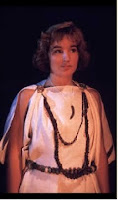After (hand)sewing the tube for my peplosdress together I found out that it wasn't wide enough to drape well. So I have decided to make a viking undertunic out of that fabric and try to save some money for the right fabric. If I am honest I have to say that I don't really mind that it didn't work out with this wonderfull grey linen. Now I have more time to do research on the costume and the accessories and I can make a more accurate reconstruction. Only downside is that it will take more time and money, but I hope and think that the end result will be worth it. Meanwhile I have ordered a magazine (Kostuum 1996/Costume 1996) with a article written by S.Y. Comis -De Kleding van de prinses van Zweeloo (The costume of the princess of Zweeloo) to start my research off with.
More information:
 Prinses van Zweeloo - Encyclopedie Drenthe Online (Dutch)
Prinses van Zweeloo - Encyclopedie Drenthe Online (Dutch) Drents Museum(Dutch)
Drents Museum(Dutch) Coevorden - De prinses van Zweeloo (Dutch) Studien zur Sachsenforschung'
Coevorden - De prinses van Zweeloo (Dutch) Studien zur Sachsenforschung' article Das Grab der "Prinzessin" von Zweeloo und seine Bedeutung im Rahmen des Gräberfeldes' (1977)- W.A. van Es en J. Ypey (German)
The Compleat Anachronist #59, Women's Garb in Nothern Europe, 450-1000 C.E. Frisians, Angles, Franks, Balts, Vikings and Finns pages 19- 22)(English)
Dress in Anglo-Saxon England, Gale Owen-Crocker, page 45-46, fig 31.(English)
Kostuum 1996, yearbook of de Nederlandse Vereniging voor Kostuum, Kant, Mode en Streekdracht, article by Comis.S.Y- De Kleding van de prinses van Zweeloo, p43-p45.(Dutch)
Een nieuwe reconstructie van de kleding van de 'Prinses van Zweeloo' [A new reconstruction of the costume of the 'Princess of Zweeloo'] article - S Y Vons-Comis printed in:
* Van rendierjager tot ontginner, Nieuwe Oudheidkundige Ontdekkingen in Drenthe, 33, [1988?]
* Varia Bio-Archaeologica, 74, 39-75
* Nieuwe Drentse Volksalmanak, 105, 1988, 39(151)-75(187)
In a fresh study of the ornaments and textiles, parallels were sought in Belgium, France, England, Scandinavia and Germany. The dress is now reconstructed as a long tunic with paired shoulder brooches from which a double necklace hangs, over which is a fringed cape fastened on the chest with an equal-armed brooch. Emphasis of the study is on the reconstruction of textile weaves. Date: mid-5th century.
Source: biab online















